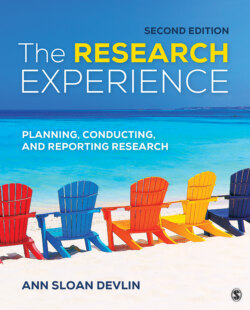Читать книгу The Research Experience - Ann Sloan Devlin - Страница 103
Confounding or Third Variables: Refining the Research Question and Closing the Research Gap
ОглавлениеEven when we ask questions that seem to have a high likelihood of producing strong relationships, they may not. Why? The gap between the variables of interest may be wide; as a result, other variables or factors that have not been measured may be better explanations of the relationship than those we have included. An extraneous variable is one that exists in the context of the study but is not being measured. There may be hundreds of extraneous variables for any given study, such as the time of day the study is taken, the age of the experimenter, the class year of the participants, or the weather outside. Extraneous variables are not automatically a problem. The real issue is whether these variables could provide an alternative explanation for your results. In an experiment when an extraneous variable changes systematically with the variables you are studying, it becomes what is known as a confounding variable (also called a third variable, usually in the context of correlation) (see also Chapters 3 and 7). Confounding variables are those the researcher failed to measure or control that provide alternative explanations for the relationship between the variables of interest. Here is an example. A college asks a researcher to test the impact of replacing mattresses in the residence halls on students’ self-reported quality of sleep. The students are randomly assigned to residence halls (a good start), but there is only enough money to replace half the mattresses, and the Facilities Department at the college has decided to replace them only in one contiguous area of campus (“south” campus) because it will make the installation process easier. The mattresses in north campus residence halls will remain the same for the year. As it turns out, north campus residence halls are near a major traffic artery, and noise from the highway is audible. Can you see the problem here? The location of the installation (south vs. north campus) systematically varies with the new vs. old condition of the mattresses. Therefore, location is a confounding variable. If the self-reported quality of sleep is better for students in south vs. north campus, you can’t rule out the possibility that it is the noise level rather than the mattress quality that makes the difference. In the case of the mattresses, random distribution of the new mattresses across both south and north campus would help to disentangle the issue of noise, and location would be included as a variable in the analysis (see Chapter 3 for a discussion of independent and quasi-independent variables).
Extraneous variable: A typically unwanted variable that exists in the context of the study but is not being measured.
Third variable: Variable that influences the relationship between the variables of interest; also called a confounding variable.
It would be impossible to measure every extraneous variable to avoid the issue of a confounding or third variable. Instead, the researcher needs to measure “the likely suspects,” and/or otherwise control for them in the research design. The likely suspects are typically those the literature suggests might be related to the variables being studied. In addition, the researcher’s observations of aspects of the situation (e.g., the location of the highway in our mattress example) are important.
As another example, would you predict a strong relationship between job performance and employee job satisfaction? Most of us would because we imagine that people who are satisfied with their jobs are productive. Yet the relationship between performance and job satisfaction is relatively small (Iaffaldano & Muchinsky, 1985). Thinking about this relationship more deeply, many factors are associated with why people are productive in their jobs, not just job satisfaction.
